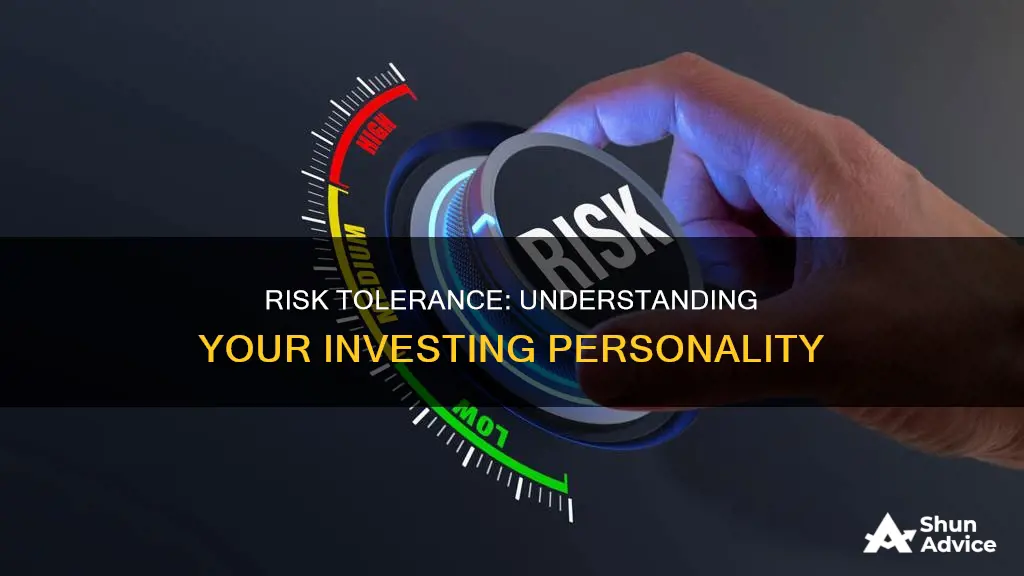
When it comes to investing, understanding your risk tolerance is key. Risk tolerance refers to how much financial risk you're comfortable taking on. It's shaped by your personality, age, financial goals, and circumstances. For instance, if you're saving for retirement, you may be more open to risk as you have time to recover from short-term market swings. In contrast, those closer to retirement may opt for a more conservative approach. Your risk tolerance can also be influenced by your liquidity needs, time horizon, and the importance of the goal to your financial well-being. Ultimately, determining your risk tolerance is crucial as it guides your investment strategy and helps you build a portfolio that aligns with your comfort level and goals.
| Characteristics | Values |
|---|---|
| Risk tolerance definition | An investor's ability and willingness to lose some or all of an investment in exchange for greater potential returns |
| Risk tolerance vs risk capacity | Risk capacity is how much investment risk you are able to take on, which is determined by your financial situation. Risk tolerance is the level of risk an investor is willing to take. |
| Factors determining risk tolerance | Personality, age, financial goals, liquidity needs, time horizon, importance of the goal to financial well-being, investment experience, and when you need to access the money |
| Risk tolerance types | Aggressive, medium, and conservative |
| Determining risk tolerance | Asking yourself questions about your financial goals, time horizon, comfort with short-term loss, non-invested savings, and tracking investments |
What You'll Learn

Risk tolerance vs. risk capacity
Risk tolerance and risk capacity are two distinct concepts that are often used interchangeably but have distinct meanings. While they are both crucial for crafting a balanced and effective investment strategy, they represent different aspects of an investor's relationship with risk.
Risk Tolerance
Risk tolerance refers to an individual's psychological willingness to take on risk. It is about emotional and psychological comfort with risk and is influenced by factors such as personality, past experiences, need for stability, and various behavioural biases. Risk tolerance is subjective and varies from person to person, but it tends to be influenced by age, gender, and income. It can also change over time due to life events, age, and economic conditions.
Risk Capacity
On the other hand, risk capacity relates to the financial ability to endure potential losses. It is determined by concrete financial circumstances such as income, debt, insurance coverage, dependents, and time horizon. Risk capacity is not influenced by emotions or individual disposition but by objective financial factors. It sets a tangible boundary on the level of risk one can afford to take, regardless of their willingness to take on risk.
Tolerance vs. Capacity
While risk tolerance and risk capacity are independent of each other, it is important to assess them together when making investment decisions. Achieving harmony between these two facets is crucial for a sustainable and fruitful investment journey. A well-considered approach involves understanding one's risk tolerance through self-assessment and professional guidance, and determining one's risk capacity through a detailed financial analysis. This information can then be used to construct a balanced portfolio that respects both the investor's emotional comfort and financial reality.
Smart Investment Decisions in India: A Guide
You may want to see also

Your willingness to take risks
Some people are comfortable with putting a large percentage of their wealth into volatile assets and high-risk investments, such as stocks, hedge funds, private equity, or cryptocurrency. They seek high returns and are willing to accept the potential for substantial losses. On the other hand, some investors are more conservative and risk-averse, preferring lower-risk investments like bonds, treasuries, and cash.
Your personality plays a role in your willingness to take risks. Some individuals are more comfortable with uncertainty and the thrill of investing, while others are more cautious and worry about potential losses. It's important to assess your behavioural tendencies and how you've reacted to market changes in the past.
Additionally, your financial goals and investment experience can influence your willingness to take risks. If you're investing for the long term, such as for retirement, you may be more open to risk as you have more time to recover from short-term market swings. However, if you're nearing retirement or have specific short-term financial goals, you may prefer a more conservative approach to reduce the potential for major losses.
It's worth noting that your willingness to take risks tends to be a stable part of your personality and may not change significantly over time, even as your financial position evolves. Therefore, understanding your comfort level with risk is crucial when making investment decisions and constructing your investment portfolio.
Devising an Investment Portfolio: Strategies for Success
You may want to see also

Your financial ability to take risks
Investment Goals
Understanding your investment goals is essential for assessing your financial ability to take risks. Ask yourself why you are investing. Common goals include saving for retirement, funding your child's education, or purchasing a home. By identifying your specific goals, you can better evaluate the level of risk you are comfortable taking.
Time Horizon
Your time horizon refers to when you plan to use the money you have invested. Generally, a longer time horizon, such as saving for retirement, allows for taking on more risk. This is because you have more time to recover from potential losses. In contrast, a shorter time horizon, like saving for a down payment on a house, may require a more conservative approach to ensure your goal is met within the desired timeframe.
Liquidity Needs
Consider your liquidity or cash needs. As you get closer to needing the money, your ability to take risks decreases. Investing in volatile assets like stocks or high-yield bonds may not be prudent if you need to access your funds soon. Therefore, your financial ability to take risks is influenced by how soon you will need to withdraw your investments.
Importance of the Goal
The significance of the investment goal to your financial well-being also plays a role in your financial ability to take risks. For instance, if you are funding long-term care or education expenses, you may want to take a more conservative approach to lower the risk of not achieving these essential goals.
Financial Circumstances
Your overall financial circumstances, including income, expenses, and obligations, will impact your ability to take risks. If you have a stable income, minimal debts, and few financial dependents, you may have more capacity to take on risk. On the other hand, if you have a mortgage, children, or elderly parents who depend on you financially, your risk capacity may be lower.
Emergency Funds
It is important to have emergency funds set aside in liquid accounts, regardless of your risk tolerance. This ensures that you can cover unexpected expenses without having to liquidate your investments. However, if a large portion of your savings is in cash due to risk aversion, it may be a sign that you are not comfortable taking on significant financial risks.
By carefully considering these factors, you can assess your financial ability to take risks and make more informed investment decisions. Remember, your risk capacity can change over time as your financial circumstances, goals, and time horizons evolve. Regularly reviewing and adjusting your investment strategy is crucial for staying aligned with your risk tolerance and financial objectives.
Lucrative Cash Investment Opportunities: Where to Invest Your Money
You may want to see also

Your personality, age and financial goals
Your personality, age, and financial goals are key factors in determining your risk tolerance for investing.
Personality
Personality typing is a tool that helps investment advisors understand an individual investor's willingness to take risks and their behavioural tendencies. The four main personality types as per the CFA Institute's Candidate Body of Knowledge are cautious, methodical, spontaneous, and individualist.
Cautious investors make decisions based on feelings and are sensitive to investment losses. They tend to have a low-risk tolerance and prefer conservative investments. Methodical investors, on the other hand, follow a disciplined and mechanical investing strategy based on hard facts and investment research. They tend to have a lower risk tolerance.
Spontaneous investors make decisions based on feelings and frequently second-guess themselves and the advice of others. They often chase investment fads and may have a higher risk tolerance. Individualist investors make decisions based on hard facts and do not often second-guess their investments. They are usually less risk-averse.
Age
Your age plays a crucial role in determining your risk tolerance. If you are decades away from retirement, you may be more comfortable taking on higher-risk investments as you have time to recover from any short-term market swings. On the other hand, if you are retired or nearing retirement, you may prefer a more conservative investment strategy to preserve your capital.
Financial Goals
Your financial goals and investment horizon are also important considerations. If you are investing for the long term, such as for retirement, you may be able to take on more risk as you have a longer time horizon for your investments to recover from any downturns. However, if you are saving for a short-term goal, such as a down payment on a house, you may have a lower risk tolerance as your investments have less time to recover from potential losses.
Your financial goals will also influence your risk tolerance. For example, if you are funding long-term care or saving for your children's education, you may want to take a more conservative approach to lower the risk of not achieving your goals.
In conclusion, understanding your personality type, age, and financial goals is crucial in determining your risk tolerance for investing. By considering these factors, you can make informed investment decisions that align with your comfort level and objectives.
Energy Equity Investment: Strategies for Success
You may want to see also

Your investment goals
Investment Purpose
Start by asking yourself, "Why am I investing?" Understanding your motivation for investing is essential for evaluating how much risk you are willing to take. Common investment goals include saving for your child's education, achieving financial independence, or building a fund for retirement. Knowing your specific goals will help you assess your risk tolerance and make informed investment decisions.
Time Horizon
Risk-Return Trade-off
When considering your investment goals, it's essential to understand the trade-off between risk and return. Investments with higher potential returns often come with higher risk. Ask yourself how comfortable you are with the possibility of substantial losses in pursuit of higher returns. This will help guide your investment strategy and the types of assets you choose for your portfolio.
Impact of Age
Your age plays a significant role in shaping your investment goals and risk tolerance. If you are decades away from retirement, you may feel more comfortable taking on riskier investments since you have time to recover from market swings. On the other hand, individuals who are retired or approaching retirement may prefer a more conservative approach to preserve their savings.
Emergency Funds
While investing in the market, it is crucial to have emergency funds set aside in liquid accounts. This ensures that you have financial backup in case of unexpected events like job loss or medical emergencies. Keeping a substantial amount of savings in cash or low-risk assets indicates a lower risk tolerance, as you may be nervous about investing in more volatile options.
Regular Monitoring
What is Invested Capital? Equity or Asset?
You may want to see also
Frequently asked questions
Risk tolerance is the level of risk an investor is willing to take. It is the amount of financial risk you're comfortable taking when investing.
Understanding your risk tolerance can help you create a portfolio that feels right for you. That means selecting investments and building an asset allocation that reflects your appetite for risk.
You can determine your risk tolerance by asking yourself questions like: How do you feel about risk? How many years do you have until retirement? What are you investing for?







